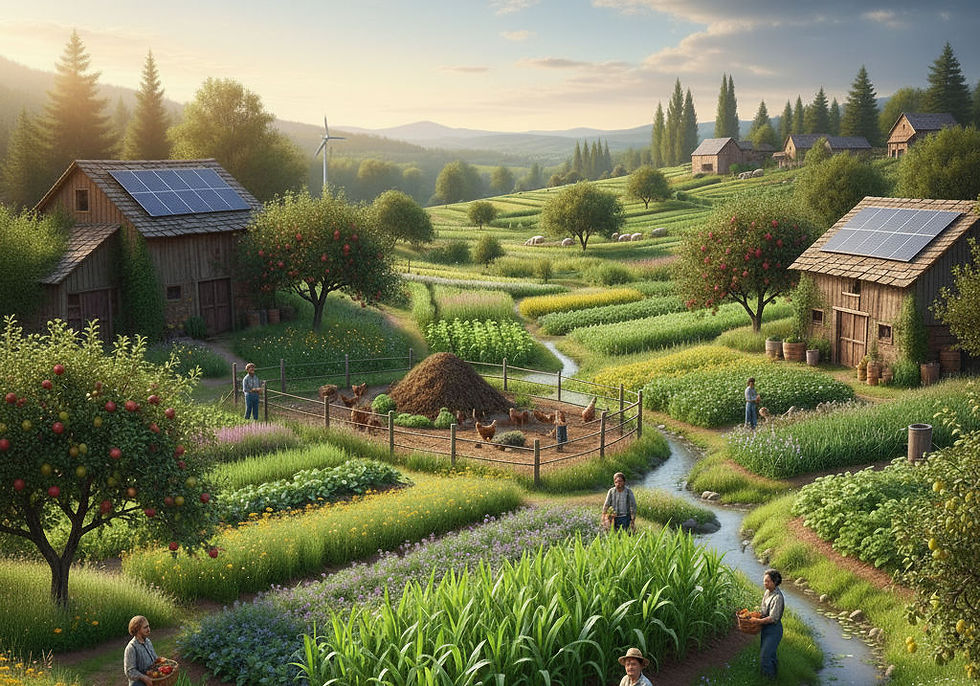Shatter the Status Quo: The Surprising Power of Regenerative Agriculture
- Ron Frazer
- 3 days ago
- 3 min read
Updated: 2 days ago
Debunking Corporate Myths to Reveal the Necessity of Regenerative Agriculture

Despite growing evidence supporting the benefits of regenerative agriculture, myths perpetuated by powerful corporations continue to mislead the public. In this article, we'll delve into the realities behind these myths and reveal why regenerative agriculture1 (RA) is crucial for the health of our planet and its inhabitants.
Regenerative agriculture is an ecosystem-based approach that seeks to actively reverse climate change by restoring degraded soil biodiversity. It centers on five key principles: (1) minimizing soil disturbance (no-till), (2) maximizing crop diversity, (3) keeping the soil covered, (4) maintaining living roots year-round, and (5) integrating livestock. This system fundamentally aims to mimic nature, thereby restoring the ecological function and vitality of farmland.
The Manufacturing of Doubt
The chemical and seed giants—whose business models are built on the continuous, high-volume sale of synthetic fertilizers, pesticides, and proprietary seeds—have a clear financial incentive to defend the industrial, conventional farming model. Their primary tactic is to sow doubt regarding RA's efficacy and its ability to operate at scale.
Myth 1: Regenerative Agriculture Cannot Feed the World. This is arguably the most widespread corporate lie. Current research2, however, demonstrates that while initial yields during a transition period may fluctuate, mature regenerative systems often match or even surpass conventional yields, especially when accounting for resilience. By significantly increasing Soil Organic Matter3 (SOM), regenerative farms become vastly more drought-resistant, ensuring stable harvests during the extreme weather events that are becoming increasingly common due to climate change. The focus shifts from volume at all costs to stability and security.
Myth 2: It’s Too Costly and Complex for Farmers. Corporations often position RA as a high-risk experiment. The reality, confirmed by economic studies, is that reducing dependency on manufactured inputs is a fast track to farmer profitability4. The substantial cost savings from buying less fertilizer, fungicide, and pesticide can quickly outweigh the costs of cover crop seeds or specialized no-till equipment, leading to higher net returns even with comparable yields5. RA builds natural capital—healthier soil—a long-term asset that conventional farming actively depletes.
The Crucial Realities: Climate and HealthThe global shift toward regenerative practices is urgent because RA addresses interconnected threats to our planet and public health simultaneously.6
The Planetary Necessity: Carbon and WaterWhen managed regeneratively, soil transforms from a carbon emitter back into a powerful carbon sink7. Global scientific consensus, notably through initiatives like the “4 per 1000” Initiative, suggests that increasing the world’s agricultural soil carbon stocks could offset a substantial portion of annual anthropogenic CO2 emissions8.
Furthermore, the structure created by healthier soil—rich in organic matter and fungal networks—acts like a massive sponge. Regenerative fields can infiltrate and hold up to eight times more water than degraded land. This enhanced water retention is a dual defense: it protects against soil erosion and flooding during heavy rains, and it secures water resources for crops during prolonged dry spells, providing critical climate change adaptation.
The Health Imperative: Nutrition and Safety — Beyond the reduced exposure to chemical residues, RA offers a direct benefit to human health through nutrient density.9 A robust, biologically active soil microbiome is essential for making essential minerals and vitamins bioavailable to plants. Research is increasingly showing that crops grown in these living soils have higher concentrations of crucial micronutrients, like zinc and iron, and beneficial compounds, such as antioxidants, compared to those grown in chemically-dependent, dead soils.
Regenerative agriculture is not simply a better way to farm; it is the necessary blueprint for a stable food system and a healthier planet. It is time to look past the manufactured myths and invest in the future beneath our feet.
Regenerative Agriculture Profitability for US Farmers | BCG, accessed November 6, 2025,https://www.bcg.com/publications/2023/regenerative-agriculture-profitability-us-farmers
An analysis of the costs and incentives for regenerative agriculture ..., accessed November 6, 2025, https://www.wbcsd.org/resources/closing-the-gap-an-analysis-of-the-costs-and-incentives-for-regenerative-agriculture-in-europe/
SL447/SS661: Raising Soil Organic Matter Content to Improve Water Holding Capacity - UF/IFAS EDIS, accessed November 6, 2025,https://edis.ifas.ufl.edu/publication/SS661
The Economics of Regenerative Agriculture - USDA ARS, accessed November 6, 2025, https://www.ars.usda.gov/oc/utm/the-economics-of-regenerative-agriculture
The Long-Term Yield Paradox: Why Regenerative Agriculture Outperforms Precision Agriculture Over Multiple Years, accessed November 6, 2025, https://researchforagriculture.com.au/the-long-term-yield-paradox/
Can soil save us? Unearthing the new '4 per mille' soil health initiative | Sustainability, accessed November 6, 2025,https://sustainability.colostate.edu/humannature/erika-foster/
Exploring the Critical Role of Water in Regenerative Agriculture; Building Promises and Avoiding Pitfalls - Frontiers, accessed November 6, 2025, https://www.frontiersin.org/journals/sustainable-food-systems/articles/10.3389/fsufs.2022.891709/full
The 4p1000 initiative: Opportunities, limitations and challenges for implementing soil organic carbon sequestration as a sustainable development strategy - PMC - PubMed Central, accessed November 6, 2025, https://pmc.ncbi.nlm.nih.gov/articles/PMC6889108/
Regenerative Organic Agriculture and Human Health: The Interconnection Between Soil, Food Quality, and Nutrition - PubMed Central, accessed November 6, 2025, https://pmc.ncbi.nlm.nih.gov/articles/PMC12108233/



Comments